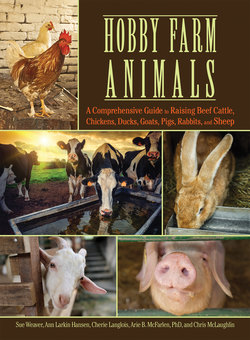Читать книгу Hobby Farm Animals - Chris McLaughlin - Страница 6
На сайте Литреса книга снята с продажи.
How Cattle Sense the World
ОглавлениеCattle have excellent eyesight, but it works a little differently from human sight. They can see color to some extent, and they see exceptionally well in the dark. Because their eyes are spaced so far apart, their horizontal vision (side to side) spans an amazing 300 degrees at a time, with their only blind spot directly behind them.
| Did You Know? Domestic cattle, which belong to the genus and species Bos taurus, have no wild siblings. The last known wild aurochs, or Bos primigenius, a cow, died in Poland in 1627. Other members of the bovine group are bison and yaks. Sheep, goats, and pigs are more distantly related, belonging to the same family, Bovidae, as cattle. |
However, their vertical (up and down) range of vision is limited to 60 degrees, which means that they have to look down to see where to put their feet when the footing is unfamiliar. What’s more, their eyes work somewhat independently of one another, rather than in concert as our eyes do, which gives them poor depth perception. When herding cattle, it is important not to work directly behind them; they can’t see you there and will either turn to look at you or spook and run away. When moving cattle into a new area, give them plenty of time to see where to put their feet.
Cattle’s sense of hearing is acute, and they can swivel their ears around to hear even better. They dislike loud, sharp noises such as yells from handlers, but they are soothed by soft talking or singing.
Cattle use quite a bit of verbal communication. They know one another’s voices, and they’ll learn yours. They’ll bellow for feed, bawl for their calves, and moo back when you call them. A cow has a special low moo for when her calf is fed and settled and all’s right with the world.
Cattle have a superb sense of smell, which they can use to follow the trail of their calves and to tell different plants apart. They also have a strong sense of taste and, as a result, have strong preferences for some plants over others. Research by Utah State University professor of rangeland science Fred Provenza has demonstrated that calves learn their plant preferences from their mothers and remember them all their lives. Year after year, they’ll seek out their favorite grazing spots. We have one small patch of bluegrass that always gets grazed to the ground before anything else is touched, although it looks no different from any other bluegrass!
The main beef cattle breed in the United States is the Hereford.
